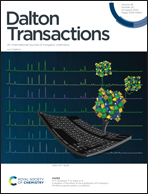Hydration of α-UO3 following storage under controlled conditions of temperature and relative humidity†
Abstract
Changes in chemical speciation of uranium oxides following storage under varied conditions of temperature and relative humidity are valuable for characterizing material provenance. In this study, subsamples of high purity α-UO3 were stored under four sets of controlled conditions of temperature and relative humidity over several years, and then measured periodically for chemical speciation. Powder X-ray diffraction (XRD) analysis and extended X-ray absorption fine structure spectroscopy confirm hydration of α-UO3 to a schoepite-like end product following storage under each of the varied storage conditions, but the species formed during exposure to the lower relative humidity and lower temperature condition follows different trends from those formed under the other three storage conditions (high relative humidity with high or low temperatures, and low relative humidity with a high temperature). Thermogravimetry coupled with XRD analysis was carried out to distinguish desorption pathways of water from the hydrated end products. Density functional theory calculations discern changes in the structure of α-UO3 following incorporation of 1, 2 or 3 H2O molecules or 1, 2 or 3 OH groups into the orthorhombic lattice, revealing differences in lattice constants, U–O bond lengths, and U–U distances. The collective results from this analysis are in contrast to analogous studies that report that U3O8 is oxidized and hydrated in air during storage under high relative humidity conditions.



 Please wait while we load your content...
Please wait while we load your content...